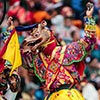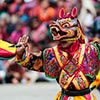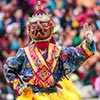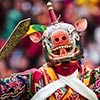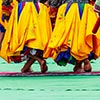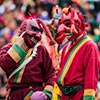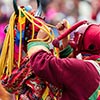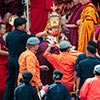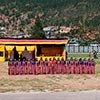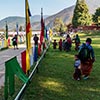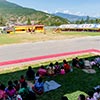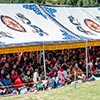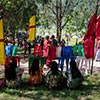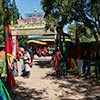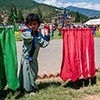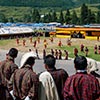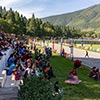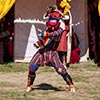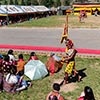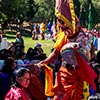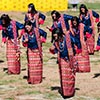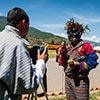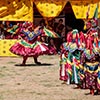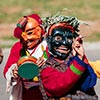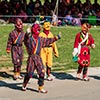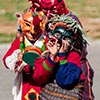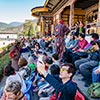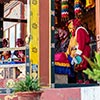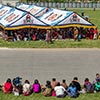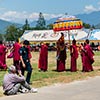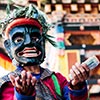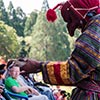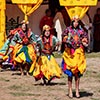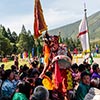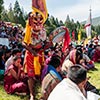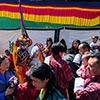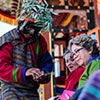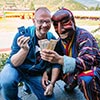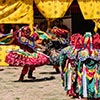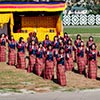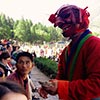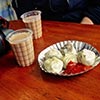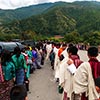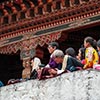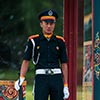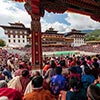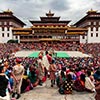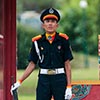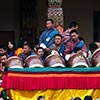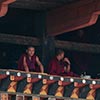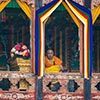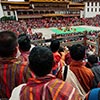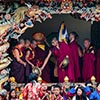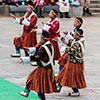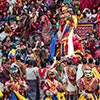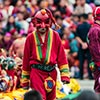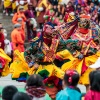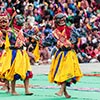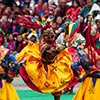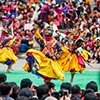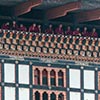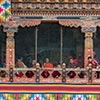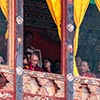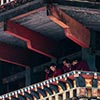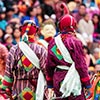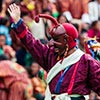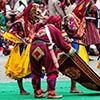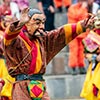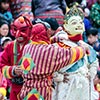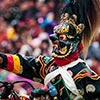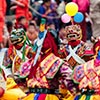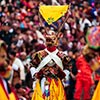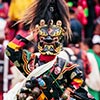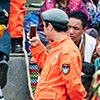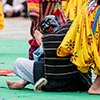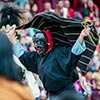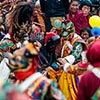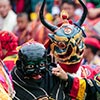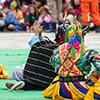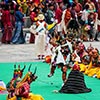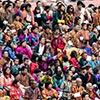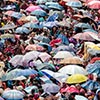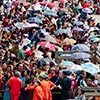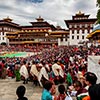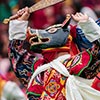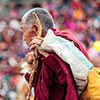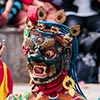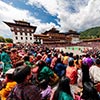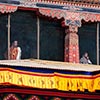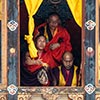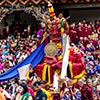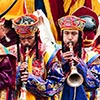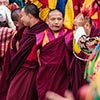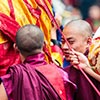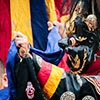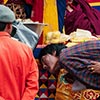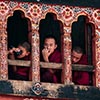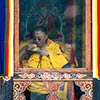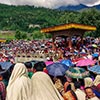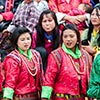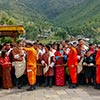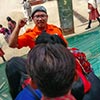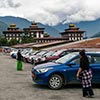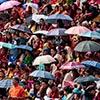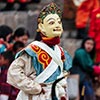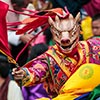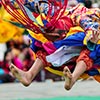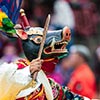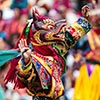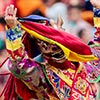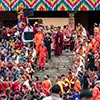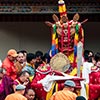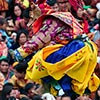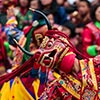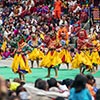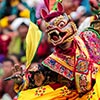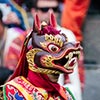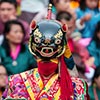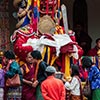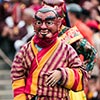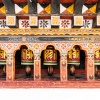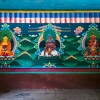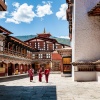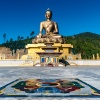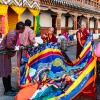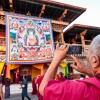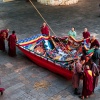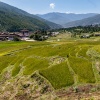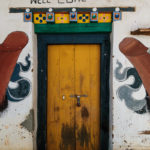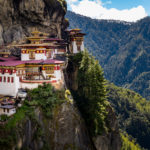Colourful Tshechu – A Visit to Bhutan Mask Festivals
The mask culture of Buddhism and Tibet is something absolutely unique. Through masks and dances the most different legends, myths, characters, but also the fight of good against evil are being told. In particular in the Kingdom of Bhutan that culture is pretty much alive and most colourful. Its strongest form of expression is Tshechu, the mask festival. I visited them in the village of Wangdue and in Bhutanese capital Thimphu.
Hours of Dancing in the Sun
Anyone thinking that it is cold at 2.000 metres above sea level is in error. Before visiting the big Thimphu Tshechu, we go to rural areas in the south of Punakha. There we attend to a smaller Tshechu and first mask festival ever in the village of Wangdue on exactly those 2.000 meters of altitude mentioned before. The sun relentlessly fries everything that is not in the shade. The organisers know this, and that’s why long tents were set up. For us western tourists free serving of SPF 50+ sun cream would be quite nice.
However, as long as we are allowed to sit on the main grandstand, everything is fine and still in shade. The faces of the dancers look less happy though. Even from a 100 meters distance one can see sweat dripping. The Wangdue Tshechu is held on the local sports field and festival ground of the village. Masses of people make the pilgrimage to the place of action, even now, at 8 o’clock in the morning…
Our driver Wangyi needs half an eternity until he could find some space to park our car. The local police is friendly, but has everything under tight control. Barriers and guards everywhere don’t even let kids through, who often play with guns and rifles. The festival itself is surrounded by a flea market and carnival. Under inhospitable, blue plastic tarpaulins the latest junk Made in China/India gets praised.
Tshechus are strongly religious, very colourful festivals and anchors of Bhutanese Tantric Buddhism deriving from the Drukpa Lineage. Sounds quite hierarchical, is quite hierarchical and that’s also how Tshechus happen, as the (local) religious dignitaries sit firmly installed in some lodge in front of things happening. Those dignitaries get courted like the omnipresent Chairman of the State Council back in GDR times.
Finally each village, each city, each district of Bhutan (called Dzongkhag) hosts a Tshechu. And each mask festival in turn involves the local religiously important figures. The homage is directed both to the office as well as to the dignitaries. Means that the Bhutanese host and stage their Tshechus primarily for themselves and only for themselves. The festivals are not meant to entertain the international tourist crowd.
No mon, no Fun…
Tshechus are public services and participating already means to receive a blessing and the Bhutan-wide propagated happiness. Understandably, whole families, young and old, gather at those Tshechus to receive that higher goodwill. Consequently, a Tshechu is also celebrated off the dances, when all visitors wrap themselves in the finest traditional robes. That’s by the way also the official dress code.
A Tshechu can last several days. At the end relics often get unveiled. Its position is easily recognisable by the long queue of waiting people. The central element and thread of a Tshechu are the masters wearing red masks. They critically observe each dance and intervene corrective especially during the dress rehearsals. Throughout the actual Tshechu, they primarily act as clowns making penis-based jokes with and parting the audience from their cash. Yes, Bhutan nourishs and cherishs a potent phallus cult.
Strangely enough, Bhutan – compared to Nepal, for example, and from the point of view of a Western tourist – is often, not to say very often, about money. Hence I make fun posing with one of the red masked clowns. He with cash in his hand, me with a credit card. Fortunately, only cash counts as otherwise my credit card would get kidnapped quickly. The grannies next to us are amused by that, but so far, they have been asked to pay up once only…
The old game “contents and packaging” also affects Bhutan. Unfortunately, the country appears pure, close to nature and ethically correct at first sight only. Bhutan’s strong religiosity should make divine values such as charity happen all over, but somehow everything gets reduced to money. And if one looks at the fate of the Lhotshampa refugees, then one quickly comes down to Earth and to facts making Guru Rinpoche losing all incarnation stages.
Yogi Padmasambhava – The Guru Rinpoche
At the bottom line all Tshechu dances and masks go back to the legends, myths, events and traditions around Yogi Padmasambhava from Kashmir, the important Guru Rinpoche. That main apostle of Buddhism was a student of Siddhartha Gautama, that is Buddha himself. Rinpoche brought Buddhism to Tibet and hierarchically as well as Christian seen then he is someone like our St. Paul.
One of those myths is about Yeshe Tsogyal, a former empress who turned into a tiger and carried Guru Padmasambhava to the caves of Taktshang. There Rinpoche meditated whole 3 years, 3 months, 3 days, 3 hours and 3 minutes to reach the eighth incarnation level. The picturesque Tiger’s Nest Monastery in the mountains of Bhutan was built on that very spot, above the caves of Taktshang.
No matter if in a village in the mountains or in the capital Thimphu, all Tshechus are dedicated to such stories of faraway times and legends shrouded in myth. Each mask festival presents opulent historical costumes, the most diverse masks and an other-worldly blaze of colour. Some of the masks, such as the clown masks, allow the dancer to view through the eye holes. In most cases, however, the masks are worn in a way that one has to look through the mouth hole.
The dances are musically accompanied by monotonous and brassy rattling cymbals, drums and a lot of bells. Above all the lively bells remind of a driving down cattle from mountain pastures. And then you sit there, for several hours, watching the same movements of the tough struggle between ox and bull, wild boar and deer, eagle and snake.
From time to time the women are allowed to perform their calm and Asian dances. Their plaintive lamenting songs are presented by equally plaintive lamenting faces. The whole show gets topped by the Dance of the Eternals, who (my seat neighbour firmly believes in it) right now let the dead tell them about life after life.
The great Tshechu of Thimphu
Photographically I focussed on the Thimphu Tsechu of coure, that made all people flock to the concrete manège being flanged to the royal palace. Its ranks are full to bursting, making forces enforce law and order by absolutely obscure measures. Often they give you a bollocking as allegedly others wouldn’t see anything… How could you dare to stand up for 20 seconds to take a picture or just loosen your legs. A grotesque argument, against the background of an opaque wall of hundreds of sun protection umbrellas right in front of us. We also experienced situations where law enforcement forces put up meaningless barriers that virtually facilitated things like a mass panic. Rainer Schaller’s Love Parade says hello…
No matter if village or capital, a Tshechu always quickly reveals (local) hierarchies and customs. While the young monks are allowed to take a nap under the roof of one of the towers, the head monk and religious leader has to watch the whole thing seamlessly from his special lodge. He sits behind large windows, framed by colourful flags and like being set in concrete.
